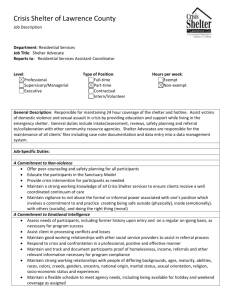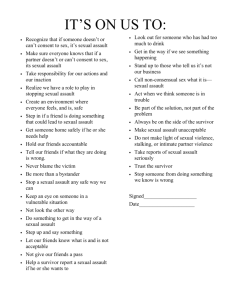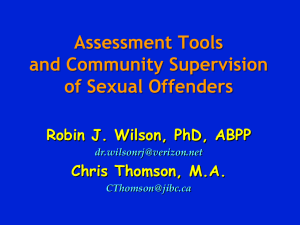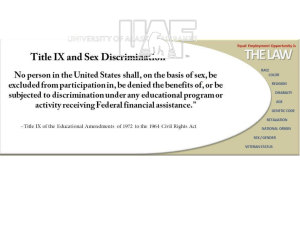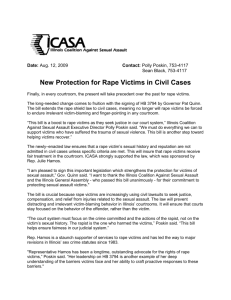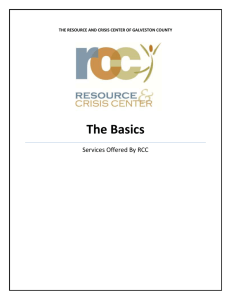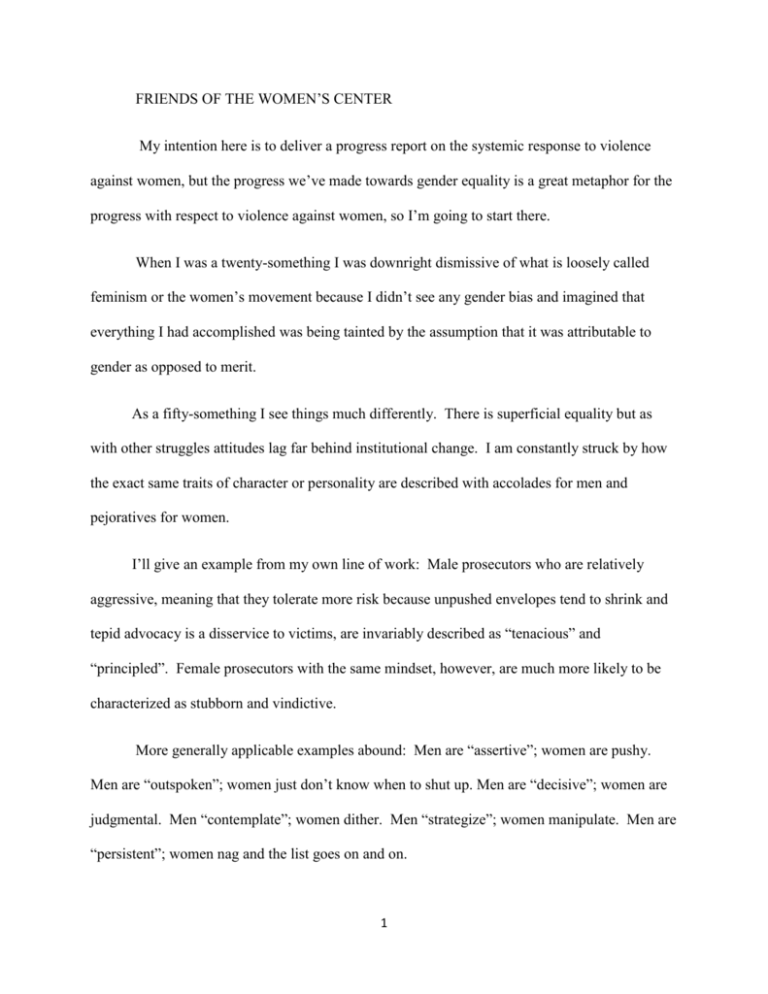
FRIENDS OF THE WOMEN’S CENTER
My intention here is to deliver a progress report on the systemic response to violence
against women, but the progress we’ve made towards gender equality is a great metaphor for the
progress with respect to violence against women, so I’m going to start there.
When I was a twenty-something I was downright dismissive of what is loosely called
feminism or the women’s movement because I didn’t see any gender bias and imagined that
everything I had accomplished was being tainted by the assumption that it was attributable to
gender as opposed to merit.
As a fifty-something I see things much differently. There is superficial equality but as
with other struggles attitudes lag far behind institutional change. I am constantly struck by how
the exact same traits of character or personality are described with accolades for men and
pejoratives for women.
I’ll give an example from my own line of work: Male prosecutors who are relatively
aggressive, meaning that they tolerate more risk because unpushed envelopes tend to shrink and
tepid advocacy is a disservice to victims, are invariably described as “tenacious” and
“principled”. Female prosecutors with the same mindset, however, are much more likely to be
characterized as stubborn and vindictive.
More generally applicable examples abound: Men are “assertive”; women are pushy.
Men are “outspoken”; women just don’t know when to shut up. Men are “decisive”; women are
judgmental. Men “contemplate”; women dither. Men “strategize”; women manipulate. Men are
“persistent”; women nag and the list goes on and on.
1
The systemic response to violence against women is in much the same posture; much
progress has been made, but attitudes are mired in the distant past.
Domestic violence prosecutions are no longer crippled by the inability of most victims,
because the underlying abusive relationship is ongoing, to testify against their assailants. As of
2006 we’ve been allowed to routinely use statements made by victims to law enforcement as
well as prior acts perpetrated by the defendant against the same and/or other victims. And,
conventional wisdom now recognizes that ending an abusive relationship isn’t nearly as easy as
it sounds, but people are still asking “Why doesn’t she just leave?” instead of “Why does he hit
her?”
Sexual assault prosecutions have likewise been aided by the general liberalization of rules
concerning the admissibility of prior acts, with the 2006 legislation providing blanket
authorization for the use of prior acts in child sexual abuse cases. The legislature has not seen fit
to allow us to routinely use statements made by sexual assault victims to law enforcement,
probably because the dynamics of sexual assault generally enable such victims to participate in
prosecutions, however, we could certainly use such legislation in the so-called Romeo and Juliet
cases, where young teenagers who have sex hopelessly confused with attention and affection and
approval become the sexual prey of much older individuals.
As with domestic violence victim-blaming is alive and well so woe to the woman who
dresses “provocatively”, allows alcohol to pass her lips, opens her door to someone whose true
intentions she failed to divine or fails to scream loudly and report promptly, but the greatest
threat to the viability of sexual assault prosecutions lies in our ever-increasing reliance on
technology in the courtroom.
2
Even before the focus on officer-involved shootings and the push for police to wear body
cameras there was a definite trend towards recordation, indeed in 2013 the legislature mandated
the recording of confessions in serious felony cases.
Body cameras will obviously restore public confidence in law enforcement but there
remain both pros and cons to the generation and use of recordings as evidence. The pros consist
of all those times when it would be great if the trier of fact could hear not just what a defendant
said but how he or she said it because it’s difficult for witnesses to describe, e.g., the sense of
entitlement or lack of empathy that comes across loud and clear on a recording.
The list of cons is considerably longer. Overt recording causes suspects to clam up, to
say the very least. Surreptitious recording is hard to accomplish in the field. Participants in
recorded conversations tend to stray into inadmissible territory such that recordings have to be
heavily edited. Recordings of interviews shift the focus from the answers obtained to the
questions asked, indeed defendants are already using experts to attribute their incriminating
answers to “false confession syndrome” predicated upon the supposed suggestibility of
competent adults, a theory once used solely to discredit the disclosure of sexual abuse by very
young children,
All of the above cons pale, however, in comparison to this inescapable truth: When we
make recording the gold standard we are communicating to the world that everything not
recorded is inferior, unreliable and untrustworthy.
To elaborate, there will always be cases that have to be proven the old-fashioned way,
with the testimony of witnesses, and sexual assault cases top that list for a variety of reasons.
Sexual assaults first of all occur in private, such that there are rarely any witnesses other than the
3
victim. Physical evidence is rarely available due to instances of contact without penetration, the
use of condoms or delay in reporting, and even where its available physical evidence is usually
not helpful because the most common types of sexual assault are predicated upon the lack of
consent and all the DNA in the world won’t help us rebut a consent defense. So, cases of socalled acquaintance and date rape are already the unintended victims of the placement of
recordings on an evidentiary pedestal.
Much has been written about the so-called CSI effect, where fans of such fictional TV
shows become jurors and expect all real crimes to be solved with sophisticated scientific
evidence, but as far as I’m concerned it’s not just jurors who are susceptible to the CSI effect.
It’s also us. It’s police, prosecutors and judges. Each generation of law enforcement is
increasingly uncomfortable with cases that have to be proven the old-fashioned way, more likely
to reject cases not supported by fingerprints, DNA, surveillance video, taped confessions, etc.,
more likely to adopt that dreadful phrase used by the media to disparage sexual assault cases not
supported by physical evidence, which is to say most of them, that phrase being “its only a hesaid, she-said case.”
The law informs us that a victim’s testimony need not be corroborated in any way, but
this is an increasingly empty promise with no real solution on the horizon. Sexual assault
victims can take some solace in the fact that it’s not necessarily personal, that the absence of an
instant replay now generates doubt across the board, but just as police themselves are embracing
body cameras as a means of defending themselves against allegations of excessive force, the
same technology, carried alongside yesterday’s whistles and pepper spray, may someday enable
women to protect themselves from the courtroom stalemate.
4

